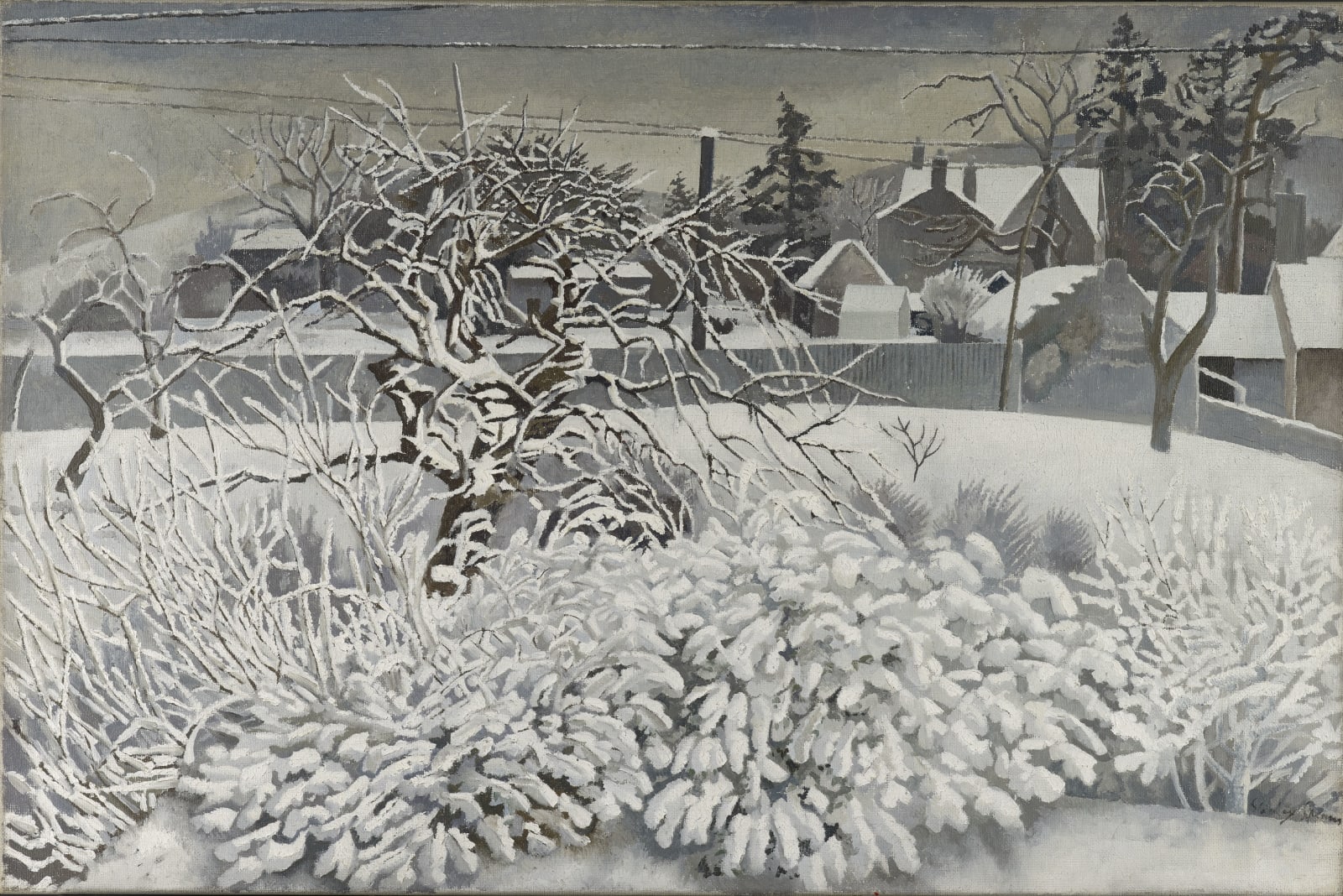Stanley Spencer 1891-1959
Apple Trees in Snow, 1940
oil on canvas
20 x 30 inches
50.8 x 76.2 cm
50.8 x 76.2 cm
In 1938, after the breakdown of his second marriage, Stanley Spencer left his beloved Cookham and moved to Hampstead. The following July he travelled with friends and fellow artists George...
In 1938, after the breakdown of his second marriage, Stanley Spencer left his beloved Cookham and moved to Hampstead. The following July he travelled with friends and fellow artists George and Daphne Charlton to the rural village of Leonard Stanley in Gloucestershire, staying there until 1941. During this period, Spencer produced around a dozen landscape paintings in and around the area, including this work, a magnificent garden view of apple trees blanketed in snow. A handwritten list in the artist’s notebook from 1942-3, now in the Tate Gallery archive, reveals that in the year Apple Trees in Snow was painted, Spencer made only three other landscapes, making this a rare example of its time.
In the 1920s, Spencer established a compositional format for his landscapes, which combined a section of foreground detail with a backdrop of deep perspective. By the 1930s, the foreground of such paintings took on a heightened level of detailed analysis. For example, in Landscape in North Wales, 1938, Spencer depicts minute sections of rust on the barbed wire that crosses the breadth of the canvas, and in View from the Tennis Court, Cookham, 1938, he pays great attention to detailing green moss growing on the wooden fencing, which, intriguingly, forms a key feature of the composition. These somewhat inconsequential details, which the artist could have chosen to omit, are a testament to his delight in capturing each and every aspect of his surroundings.
Spencer’s exacting observation of nature is particularly evident in this work, where the overhead telephone wire is highlighted with thin brushstrokes of white, evoking the glisten of fallen snow. The composition focuses on the apple trees, and the complex design of their individual criss-crossing twigs and spindly branches is recorded faithfully, with skilful ease.
Apple Trees in Snow is devoid of figures and as such there is an overwhelming impression of quiet. This is further reinforced by the snow, which lies completely untouched, conveying a notion of stillness and hibernation. The image is pregnant with a feeling of expectation, of the sun to come out, the snow to melt and new growth. Unlike Spencer’s other landscapes, which offer an idealistic vision of the English countryside, often evoking ‘a feeling of idyllic warmth and sensuousness’, this work, dominated by blueish-grey, brown and white tones, is imbued with an intense poetic melancholy. (1) The painting can be read as a mirror not only of Spencer’s emotional state, but also of the collective mood felt during the Second World War.
(1) Keith Bell, Stanley Spencer: A Complete Catalogue of the Paintings, Phaidon, London, 1992, p300
In the 1920s, Spencer established a compositional format for his landscapes, which combined a section of foreground detail with a backdrop of deep perspective. By the 1930s, the foreground of such paintings took on a heightened level of detailed analysis. For example, in Landscape in North Wales, 1938, Spencer depicts minute sections of rust on the barbed wire that crosses the breadth of the canvas, and in View from the Tennis Court, Cookham, 1938, he pays great attention to detailing green moss growing on the wooden fencing, which, intriguingly, forms a key feature of the composition. These somewhat inconsequential details, which the artist could have chosen to omit, are a testament to his delight in capturing each and every aspect of his surroundings.
Spencer’s exacting observation of nature is particularly evident in this work, where the overhead telephone wire is highlighted with thin brushstrokes of white, evoking the glisten of fallen snow. The composition focuses on the apple trees, and the complex design of their individual criss-crossing twigs and spindly branches is recorded faithfully, with skilful ease.
Apple Trees in Snow is devoid of figures and as such there is an overwhelming impression of quiet. This is further reinforced by the snow, which lies completely untouched, conveying a notion of stillness and hibernation. The image is pregnant with a feeling of expectation, of the sun to come out, the snow to melt and new growth. Unlike Spencer’s other landscapes, which offer an idealistic vision of the English countryside, often evoking ‘a feeling of idyllic warmth and sensuousness’, this work, dominated by blueish-grey, brown and white tones, is imbued with an intense poetic melancholy. (1) The painting can be read as a mirror not only of Spencer’s emotional state, but also of the collective mood felt during the Second World War.
(1) Keith Bell, Stanley Spencer: A Complete Catalogue of the Paintings, Phaidon, London, 1992, p300
Provenance
Redfern Gallery, 1946
No record
Redfern Gallery, 1952
Miss Hannah Gluck
Christie's
Anthony D'Offay Gallery
Sotheby's 1990
Ivor Braka Ltd., London
Exhibitions
Leicester Galleries, 1942
Redfern Gallery,Coronation Exhibition, 1953, cat no.98
Literature
Keith Bell,Stanley Spencer: A Complete Catalogue of the Paintings, Phaidon Press Ltd., London, 1992, illus b/w cat no.291, p466
Join our mailing list
* denotes required fields
We will process the personal data you have supplied to communicate with you in accordance with our Privacy Policy. You can unsubscribe or change your preferences at any time by clicking the link in our emails.
